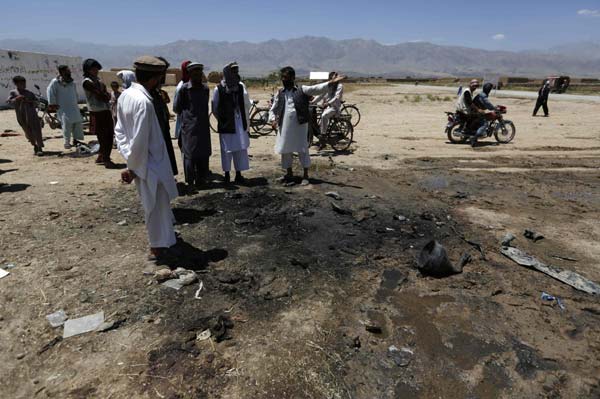UN: Afghan civilian death toll up so far this year
Updated: 2014-07-09 15:28
(Agencies)
|
|||||||||||
 |
|
Afghan villagers stand at the site of an attack in Parwan province July 8, 2014. At least four NATO servicemen were killed in an attack in eastern Afghanistan on Tuesday, the International Security Assistance Force said.[Photo/Agencies] |
KABUL, Afghanistan - The number of Afghan civilians, including children, killed in violence rose by nearly 17 percent in the first half of this year, compared with the same period in 2013 as the fight is increasingly taking place closer to homes in populated areas, the UN said Wednesday.
The worrying trend comes as the Taliban and other militants grow bolder with their attacks on Afghan security forces in the fight for control of key routes and other territory ahead of the withdrawal of US and allied combat troops by the end of 2014.
Afghans have frequently been caught up in the violence threatening their country, but the 85-page biannual UN report said that so far this year clashes, rockets and mortar strikes killed more civilians than roadside bombs and suicide attacks, a change from the past when most civilian casualties were blamed on roadside bombs.
It said the shift was directly related to the closure and transfer to Afghan security forces of more than 86 bases belonging to the US-led coalition as well as an increase in assaults against a growing number of Afghan checkpoints and patrols near markets and public roads.
"This heightened their exposure to attacks ... and often led to civilians, particularly women and children, being caught in the crossfire,'' the report said.
The findings were especially troubling because they threaten to undermine confidence in Afghan soldiers and police who are struggling to show they can protect the people as most foreign forces leave by the end of the year.
US President Barack Obama has said he wants to leave nearly 10,000 troops in Afghanistan to help train Afghan security forces and to stage counterterrorism operations. But outgoing President Hamid Karzai has refused to sign a bilateral security agreement that would allow the Americans to stay, saying he was leaving the decision to his successor.
In all, 1,564 civilians were killed from January through June, compared with 1,342 in the first six months of 2013, the UN said. That included a 21 percent jump in the death toll for children, with 295 killed so far this year compared with 243 in the same period the previous year.
Meanwhile, the number killed from ground engagements including mortar attacks and rocket-propelled grenades that hit homes, agricultural fields and playgrounds during the same period more than doubled, from 219 to 474. Roadside bombs killed 463 civilians and suicide bombings and other complex attacks killed 156, the report said.
"The fight is increasingly taking place in communities, public places and near the homes of ordinary Afghans, with death and injury to women and children in a continued disturbing upward spiral,'' Georgette Gagnon, the director of human rights for the UN mission in Afghanistan, said in a news release.
Tensions surrounding the April 5 election and a June 14 runoff vote to replace Karzai, the only leader that the country has known since the US invasion that ousted the Taliban in 2001, also took a toll on civilians, with 173 deaths from attacks targeting electoral officials in convoys, polling centers or candidates and their supporters.
Karzai was constitutionally barred from seeking a third term. The two candidates who faced off in the disputed second round, Abdullah Abdullah and Ashraf Ghani Ahmadzai, have both promised to sign the security pact with the US.
The UN also said the Taliban and other insurgents continued to be the main cause of civilian casualties, noting the number of civilians killed by militants doubled to 1,208 in the first half of this year, compared with 599 in the same period of 2009, when UNAMA first began keeping track of civilian casualties.
In line with their diminishing presence in Afghanistan, the number of civilians killed by international airstrikes dropped to 25 compared with 49 in the first half of 2013, the report said.
It called on the Afghan government to try to mitigate the number of civilians killed and wounded by revising and strengthening tactical directives, rules of engagement and ensuring proper training on protection measures and accountability.
Related Stories
Fraud claim mars Afghan voting 2014-06-18 07:18
Threats haunt Afghan vote 2014-06-13 07:28
Afghan presidential runner escapes bombing 2014-06-06 17:02
Halting dollar transaction with Afghan banks baseless 2014-06-01 21:48
12 Afghan civilians killed in roadside bombing 2014-05-31 14:31
Chinese president meets Afghan President Hamid Karzai 2014-05-19 20:09
Today's Top News
For Brazil fans, a debacle worse than 1950
Tesla faces suit over trademark
Rich eye overseas game hunting
E-commerce giants go rural
Scolari apologizes for Brazil's World Cup failure
China, Germany join hands to drive growth
Meet foreigner breed of workers
Product placement deal backfires
Hot Topics
Lunar probe , China growth forecasts, Emission rules get tougher, China seen through 'colored lens', International board,
Editor's Picks

|

|

|

|

|

|





